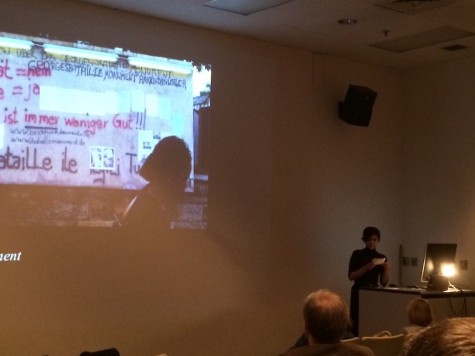Art History Colloquium held at Folk Hall
November 3, 2014
On Monday, Nov. 3, Myers School of Art hosted an Art History Colloquium that featured theses by Kelly Hartleib and Katherine Nikitin.
Hartleib’s thesis looks at the model of French painter Edouard Manet, and the muse who posed throughout his works. The model was Victorine Meurent and who later became a mistress of Manet. The thesis examined Meurent’s involvement with Manet’s works and how nude modeling was viewed during the time period.
Manet painted Meurent between 1861 and 1872 in a number of his famous works including “Olympia,” “Woman with a Parrot,” and “The Railway.”
“I wanted to explore other aspects of Manet’s work that haven’t yet been researched,” Hartleib said, “everything else about him has been done and I had known it prior to starting this thesis.”
Nikitin’s thesis project analyzed the works of Thomas Hirschhorn and Santiago Sierra. Both artists are more recent and have used a more contemporary form of art by using audience participation for their works.
Hirschhorn’s art pieces involved monuments and altars that were displayed in public areas in which audiences could take or leave objects to add to the art. Many objects included teddy bears, postcards and pictures but emphasized the colors of red, blue and yellow. The altars and monuments were dedicated to various philosophers that Hirschhorns admired such as Mandriam and Bataille.
These art pieces were placed all over the world in countries like France, Switzerland, Germany and even the U.S. These works were started in 1997 and continued past 2000. Hirschhorn didn’t keep up with these displays but instead left them to the communities they were placed in to do what they’d like with them. Eventually they were all taken down by the neighborhoods.
Santiago Sierra also used audience interaction but had more of a social statement with his work. Sierra used many migrant workers and citizens of poor countries to display the disparity of laborers and their employers.
Some of Sierra’s work involved tattooing lines across people’s backs to display what people are willing to do for money. The people were paid the equivalent of their country’s minimum wage to not only avoid legal issues but to also show that the minimum wage of the countries were way too low for their laborers.
Nikitin also included Sierra’s art displays of paying people to remain in cardboard boxes throughout a day.
“Many people criticized Sierra for having people remain in a box for an entire day, but Sierra argued that those people were sitting down and received the same pay as some of the guards in the building that had to stand for 8 hours,” Nikitin said.
The people hired to be in these boxes couldn’t be seen by or communicate with the audience, but the piece was supposed to get the audience to question their own opinion on social issues such as minimum wage.
Each speaker presented their thesis and audience members were allowed to ask questions about the findings afterwards. Since Nikitin and Hartleib had never met either artist before some questions posed were too specific even with the extensive research they’ve conducted.

Nikitin presents works done by Hirschhorn













